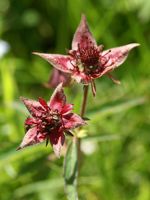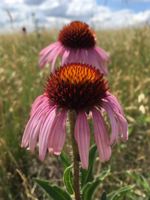Mon-Fri 9am - 5pm Mountain time
Narrow-Leaved Coneflower (Echinacea) vs Marsh Cinquefoil
Comarum palustre
Echinacea angustifolia
CUSTOM GROW
NOT AVAILABLE THIS SEASON - MIGHT RETURN
Marsh Cinquefoil is a native perennial wetland plant with striking reddish-purple, star-shaped flowers. They bloom in early to mid-summer, providing nectar for bees, flies, and other pollinators. Beyond its summer blooms, the foliage turns red in autumn, adding seasonal interest to wetland landscapes.
Common in wetlands, pond margins, and wet meadows, Marsh Cinquefoil spreads by rhizomes to form colonies or patches that contribute to shoreline stabilization. It thrives in nutrient-poor, saturated soils where many other plants struggle, making it valuable in challenging wetland conditions. With its ecological function and ornamental appeal, it is well-suited for wetland plantings, ecological restoration, and naturalized projects.
Narrow-Leaved Coneflower is a native perennial wildflower known for its pink to pale purple, daisy-like blooms. The petals (rays) droop downwards, around a dark, domed center, giving the flower a cone-like appearance. The nectar-rich blossoms attract a wide variety of pollinators, including native bees and butterflies. After flowering, the seeds provide food for birds, further adding to its ecological value.
Once established, it is drought-tolerant due to its deep taproot, which also helps stabilize soil. Narrow-Leaved Coneflower thrives in a variety of well-drained soils, including sandy, rocky, and alkaline. It often grows alongside the native grasses that characterize prairie and grassland ecosystems, making it well-suited for prairie and grassland restoration, naturalization, and pollinator gardens.

